45 Thy love, CALLITRICHE, two Virgins share,
Smit
with thy starry eye and radiant hair;—
On
the green margin sits the youth, and laves
His
floating train of tresses in the waves;
Sees
his fair features paint the streams that pass,
50 And bends for ever o’er the watery glass.
Two
brother swains, of COLLIN’S gentle name,
The
same their features, and their forms the same,
[Callitriche, l. 45. Fine-Hair, Stargrass. One male and two females inhabit each flower. The upper leaves grow in form of a star, whence it is called Stellaria Aquatica by Ray and others; its stems and leaves float far on the water, and are often so matted together, as to bear a person walking on them. The male sometimes lives in a separate flower.]
[Collinsonia. l. 51. Two males one female. I have lately observed a very singular circumstance in this flower; the two males stand widely diverging from each other, and the female bends herself into contact first with one of them, and after some time leaves this, and applies herself to the other. It is probable one of the anthers may be mature before the other? See note on Gloriosa, and Genista. The females in Nigella, devil in the bush, are very tall compared to the males; and bending over in a circle to them, give the flower some resemblance to a regal crown. The female of the epilobium angustisolium, rose bay willow herb, bends down amongst the males for several days, and becomes upright again when impregnated.]
[Genista. l. 57. Dyer’s broom. Ten males and one female inhabit this flower. The males are generally united at the bottom in two sets, whence Linneus has named the class “two brotherhoods.” In the Genista, however, they are united in but one set. The flowers of this class are called papilionaceous, from their resemblance to a butterfly, as the pea-blossom. In the Spartium Scoparium, or common broom, I have lately observed a curious circumstance, the males or stamens are in two sets, one set rising a quarter of an inch above the other; the upper set does not arrive at their maturity so soon as the lower, and the stigma, or head of the female, is produced amongst the upper or immature set; but as soon as the pistil grows tall enough to burst open the keel-leaf, or hood of the flower, it bends itself round in an instant, like a French horn, and inserts its head, or stigma, amongst the lower or mature set of males. The pistil, or female, continues to grow in length; and in a few days the stigma arrives again amongst the upper set, by the time they become mature. This wonderful contrivance is readily seen by opening the keel-leaf of the flowers of broom before they burst spontaneously. See note on Collinsonia, Gloriosa, Draba.]
With
rival love for fair COLLINIA sigh,
Knit
the dark brow, and roll the unsteady eye.
55 With sweet concern the pitying beauty mourns,
And
sooths with smiles the jealous pair by turns.




